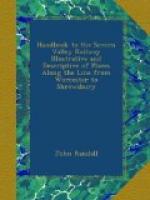Henry III., in order to afford the said anchorite, Nicholas de Denton, greater leisure for holy exercises, and to support him during his life, or so long as he should be a hermit on the aforesaid mountain, granted him six quarters of corn, to be paid by the Sheriff of Shropshire out of the Town’s Mills of Bridgnorth.
On leaving Cressage, Eyton-upon-Severn is seen on the right, and on an eminence close by is the “Old Hall,” built by Lord Chancellor Sir Thomas Bromley. It was the birthplace of Lord Herbert of Chirbury, of whom Ben Jonson wrote:—
“If men get fame for some
one virtue, then
What man art thou that art so many
men,
All virtuous Herbert! on whose every
part
Truth might spend all her voice,
Fame all her art?”
The railway now passes Cound Hall, Cound Church, and Cound Mill, a manor which Henry III. gave to his brother-in-law, Llewellyn, and which was afterwards held by Walter Fitz-Alan, who entered the service of David, King of Scotland, and became head of the royal house of Stuart. It crosses the Devil’s Causeway, and passes Venus Bank, with Pitchford and Acton Barnell on the left; the latter celebrated for the ruins of the old castle where Edward I. held his parliament, the Commons sitting in a barn.
Berrington, forty-seven miles from Worcester, and four and a half from Shrewsbury, lies a short distance from the station. Its church has many points of interest, being of Anglo-Norman and Early English architecture; it also possesses a fine Norman font, and a curious monumental figure of a cross-legged knight, carved in wood.
[Atcham Church: 39.jpg]
The little village of Atcham may be reached from here by a very pleasant foot walk of about a mile through the fields. It is celebrated as the birthplace of Ordericus Vitalis, chaplain to William the Conqueror, and a famous historian of that time. The church is an ancient structure reared on the little grassy flat round which the river bends; tresses of luxuriant ivy conceal its walls, in which are found sections of a Roman arch and a sculptured Roman column, part of the spoil of the city of Uriconium. Among its relics is a reading-desk, carved, it is supposed, by Albert Durer, with panels representing passages in the parable of the Prodigal Son.
Lord Berwick’s park adjoins the village, and in front of the mansion the Tern comes down to join the Severn. From the Bridge it is one and a half miles to
WROXETER,
[Uriconium: 40.jpg]
Where the ruins of Uriconium are still exposed to view. Here, after a lapse of 1,500 years, the visitor may tread the streets and pavements, handle the implements which the old Romans used, admire their well-turned arches, and see the paint and plaster upon the walls of their apartments. The “Old Wall,” so long a sphinx by the roadside, suggesting enigmas to passers-by, has found an interpreter in




